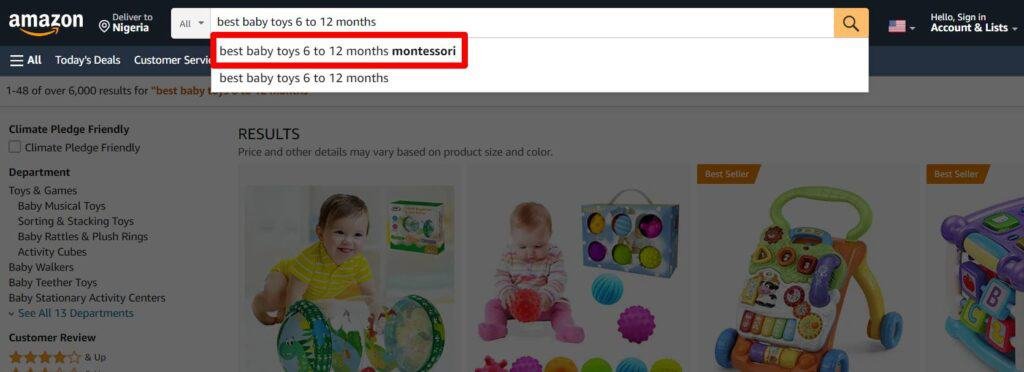If you’re selling products on Amazon, it’s important to understand how customers find your listings. Amazon’s search engine uses algorithms to rank products based on relevancy and customer engagement. By optimizing your product listings for relevant keywords, you can improve your chances of getting found by potential customers.
To help you understand how Amazon’s search engine works, we’ve put together this guide to Amazon SEO insight. We’ll cover the basics of keyword research and optimization, as well as some tips and tricks for getting your product listings to rank higher in search results.
Ready to get started? Let’s dive in!
What is Amazon SEO Insight?
Amazon SEO Insight is a tool that allows you to see how well your product listings are ranking on Amazon.com.
You can use it to track your progress over time and see what keywords and other factors are influencing your product’s visibility on the site.
In addition to showing you your overall ranking on Amazon, Amazon SEO Insight provides data on the following:
- Search terms that your listing appears for
- The number of searches for each term
- Your ranking on each search results page
- The number of products that appear above and below your listing in the search results
- Changes in your ranking over time

Search terms that your listing appears for:
The Amazon SEO Insight tool tells you what words people are using to search for your product. This way, you can see which words are the most popular and use them in your product listing to make it more visible to shoppers.
The number of searches for each term:
In addition to showing you the most popular search terms, Amazon SEO Insight also tells you how many times those terms have been searched. This way, you can gauge how popular your product is and how much demand there is for it.
Your ranking on each search results page:
Not all searches are equal. Some terms are searched more often than others, and some pages of the Amazon website get more traffic than others. Amazon SEO Insight tells you where your product ranks on each page so that you can adjust your strategy accordingly.
The number of products that appear above and below your listing in the search results:
This metric tells you how much competition there is for the keywords that you’re targeting. If there are a lot of products competing for the same keywords, it will be harder to rank highly for those terms.
Changes in your ranking over time:
Amazon SEO Insight also allows you to track your progress over time. This way, you can see how well your product is doing and adjust your strategy as necessary.
In general amazon, SEO Insight is a tool that allows you to track your product’s ranking on Amazon.com. It provides data on the most popular search terms, your ranking on each search results page, the number of products that appear above and below your listing, and changes in your ranking over time. You can use this information to adjust your Amazon marketing strategy and improve your product’s visibility on the site.
Tips on how to improve your listing’s ranking
1. Do your research.
The Amazon SEO Insight tool provides a wealth of data that can help you improve your ranking on the site. Make sure to take advantage of all that it has to offer so that you can make informed decisions about your listing.
2. Use popular keywords.
When you know which words are the most popular, you can use them in your listing to make it more visible to shoppers. Keep in mind, however, that there is a lot of competition for popular keywords, so you’ll need to be strategic about how you use them.
3. Consider your competition.
The number of products that appear above and below your listing in the search results can give you a good idea of the level of competition for the keywords that you’re targeting. If there are a lot of products competing for the same keywords, it will be harder to rank highly for those terms.
4. Track your progress.
Amazon SEO Insight allows you to track your ranking over time, so make sure to check in on your progress regularly. This way, you can see how well your product is doing and make necessary adjustments to your listing or marketing strategy.
5. Make changes as needed.
Your ranking on Amazon can change over time, so be sure to revisit your listing and make changes as needed. This could include adding new keywords, changing your product description, or adjusting your pricing. By regularly monitoring your listing and making changes as needed, you can keep your product visible and increase your chances of making a sale.
6. Get help from an expert.
If you’re not sure how to use the Amazon SEO Insight tool or want help improving your ranking on the site, consider working with an expert. An experienced Amazon consultant can provide valuable guidance and help you create a listing that stands out from the competition.
Why is Amazon SEO Insight Important?
Amazon SEO Insight is important because it allows you to track your product’s ranking on Amazon.com. It provides data on the most popular search terms, your ranking on each search results page, the number of products that appear above and below your listing, and changes in your ranking over time. This information can help you make informed decisions about your Amazon marketing strategy and improve your product’s visibility on the site.
When you track your ranking with Amazon SEO Insight, you can see how well your product is doing and make necessary changes to your listing or marketing strategy. This could include adding new keywords, changing your product description, or adjusting your pricing. By regularly monitoring your listing and making changes as needed, you can keep your product visible and increase your chances of making a sale.
What is the Amazon A9 algorithm And Does It Work?
The Amazon A9 algorithm is a complex ranking system that takes into account a variety of factors to determine the order of search results. Some of these factors include:
- Relevance of the product to the search term
- The historical buying behavior of the customer
- The popularity of the product
- The price of the product
- The quality of the product
- The shipping time and costs
- The customer reviews
All of these factors are taken into account when Amazon A9 ranks search results. However, the algorithm is constantly changing and evolving, so it’s important to stay up to date on the latest changes.
The customer reviews:
One of the most recent changes to the Amazon A9 algorithm is the addition of a new factor: product reviews. Product reviews are now being used as a ranking signal, which means that products with more positive reviews will be ranked higher in search results. This change is significant because it shows that Amazon is placing more emphasis on customer satisfaction and quality control.
The shipping time and costs:
Another change that has been made to the Amazon A9 algorithm is the way that shipping time and costs are factored into the ranking. In the past, these two factors were not given much weight. However, they are now being taken into account more heavily, which means that products with faster shipping times and lower shipping costs will be ranked higher in search results.
As you can see, the Amazon A9 algorithm is constantly changing and evolving. It’s important to stay up to date on the latest changes so that you can ensure that your products are being ranked correctly.
There are believed to be over 100 different ranking factors that are used by the algorithm, which makes it difficult to know exactly what influences a product’s position in the search results. However, some general principles are known to impact ranking.
Some of the most important ranking factors are:
Relevance:
This means that products that are more relevant to the keywords being searched for are likely to be ranked higher than those that are less relevant.
To improve relevance, sellers can use keyword-rich titles and descriptions, as well as ensure that their products are properly categorized.
Sales Velocity:
This refers to how many sales a product has made in a given period. Products that are selling well are likely to be ranked higher than those that are not selling as well.
To improve sales velocity, sellers can offer competitive prices and promotional discounts. They can also use Amazon’s PPC (pay-per-click) advertising to make their products more visible in the search results.
Customer Reviews:
Products that have positive customer reviews are generally ranked higher than those with negative or no reviews. This is because customer reviews are seen as a good indicator of quality.
To get more customer reviews, sellers can offer incentives such as discounts or free products in exchange for positive reviews. They can also reach out to past customers and ask them to leave a review.
Product Photos:
Products with high-quality, professional photos are generally ranked higher than those with poor-quality or no photos. This is because good photos give potential buyers a better idea of what the product looks like, which can help them make a purchasing decision.
To improve the quality of their product photos, sellers can hire a professional photographer or use photo-editing software to improve the quality of their existing photos.
These are just some of the factors that are believed to impact a product’s ranking in Amazon’s search results. By focusing on these factors, sellers can improve their chances of getting their products seen by potential buyers. Read more about how amazon SEO works here.
Amazon keyword research:
As an online seller, you’re probably always looking for ways to optimize your listings and make sure they are as visible as possible to potential customers. One of the most important aspects of this is keyword research – finding the right keywords to include in your listing so that it shows up when people search for related terms on Amazon.
Unfortunately, keyword research is not always as simple as it may seem. There are a lot of factors to consider, and it can be difficult to know where to start. However, with a little guidance, you can develop a strong keyword strategy that will help your listings rank higher on Amazon and bring in more sales.
Here are some tips for doing amazon keyword research:
1. Start with your product title and description.
Your product title and description are a great starting point for keyword research. Take a look at these elements and see if there are any keywords that you could include to make your listing more visible.
2. Use Amazon’s autocomplete feature.
Amazon’s autocomplete feature is a great tool for finding relevant keywords. Simply start typing in a related search term and Amazon will suggest similar terms that people are searching for. This can give you some great ideas for keywords to include in your listing.

The keyword auto complete feature works as seen in the image above.
3. Make a list of relevant keywords
Before you can start your Amazon keyword research, you need to have a solid list of relevant keywords that you want to target. To do this, brainstorm a list of potential keywords that are related to your product or niche. Once you have your list, you can begin using various tools to help you narrow down the most effective keywords to target.
4. Use keyword research tools
There are several different keyword research tools that you can use to help you find the most effective keywords for your Amazon product listing. Some of the most popular tools include Google AdWords Keyword Planner, Wordtracker, and semrush.com.
5. Analyze your competition
Once you have a list of potential keywords, it’s important to analyze your competition to see which keywords they are targeting. To do this, simply search for your potential keywords on Amazon and take a look at the results. Pay attention to both the organic results and the sponsored results to get a better idea of which keywords are most effective.
6. Prioritize your keywords
Once you have a list of potential keywords, it’s important to prioritize them based on their effectiveness. To do this, you can use a tool like semrush.com to get an estimate of the monthly search volume for each keyword. You can also use Google AdWords Keyword Planner to get an estimate of the average CPC for each keyword.
7. Use long-tail keywords
Long-tail keywords are a great way to target potential customers who are further down the sales funnel. As they tend to be less competitive than shorter, more general keywords, so they can be a great option for getting your listing to rank higher. These keywords are typically more specific and have less search volume than broader, more general keywords. However, they can be very effective in driving conversions.

8. Use Amazon keyword tools
There are several different Amazon keyword tools that you can use to help you find the most effective keywords for your product listing. Some of the most popular tools include MerchantWords and amzscout.net.
9. Optimize your product listing
Once you have a list of keywords that you want to target, it’s important to optimize your product listing for those keywords. This includes both the title and the description of your listing. In addition, you should also use relevant keywords in your bullet points and backend keywords.
10. Use negative keywords
Negative keywords are a great way to filter out irrelevant traffic and focus your efforts on keywords that are more likely to convert. To find negative keywords, simply search for your potential keywords on Amazon and take a look at the results. If you see a lot of results that are not relevant to your product, those can be considered negative keywords.
11. Monitor your results
Once you have optimized your product listing for your target keywords, it’s important to monitor your results to see how well you are doing. There are several different tools that you can use to track your rankings, including amzscout.net and MerchantWords.
12. Make changes as needed
If you’re not seeing the results that you want, it’s important to make changes to your listing. This may include changing your title, description, bullet points, or even your target keywords. By constantly tweaking and improving your listing, you can increase your chances of ranking high for your target keywords.
13. Make sure your keywords are relevant.
Relevancy is key when it comes to keyword research. You want to make sure that the keywords you include in your listing are relevant to your product and will be used by people who are interested in what you’re selling.
However, it’s important to remember that there is no guarantee that you will rank first for your keywords. The best way to ensure success is to constantly monitor your results and make changes as needed. Learn more about amazon seo here
Important Metrics That All Amazon Sellers Should Always Track:
There are several key metrics that any amazon seller should track to ensure their listing is optimized for search and conversion. These include:
- Search term tracking: This metric allows you to see which keywords customers are using to find your listing. You can then adjust your listing title and keywords to match these terms, helping to improve your visibility in search.
- Competitor insights: Keeping an eye on your competitors is essential in any business, and Amazon is no different. By tracking their listings you can see what keywords they are targeting and what offers they are running. You can then adjust your listing accordingly to ensure you are always one step ahead.
- Always-on monitoring for all hours of the day: Amazon is a global marketplace, which means customers are searching for your products 24/7. By having always-on monitoring you can be sure that you are never missing a potential sale.
- Share of voice tracking: This metric allows you to see how often your listing appears in amazon search results. If you are not appearing as often as your competitors then you may need to adjust your listing to include more relevant keywords.
- Keyword boost: This is an amazon SEO service that can help to improve your listing’s visibility in search results. By adding relevant keywords to your listing you can ensure that you are always appearing in front of potential customers.
- Conversion rate tracking: This metric allows you to see how often customers are clicking on your listing and then making a purchase. If you notice that your conversion rate is low then you may need to make changes to your listing, such as adding more relevant keywords or improving your product photos.
These are just a few of the key metrics that you should be tracking when selling on Amazon. By monitoring these metrics you can ensure that your listing is always optimized for search and conversion.
If you’re not sure where to start, our team of amazon experts can help. We offer a range of services, including amazon keyword research, amazon listing optimization, and Amazon PPC management. Contact us today to learn more about how we can help you succeed on amazon.
Let’s Wrap Things Up:
As an Amazon seller, it’s important to have a good understanding of how Amazon’s search engine works to improve your listing’s visibility and ranking. Here are some key insights into Amazon SEO:
- Amazon uses a complex algorithm to determine which products to show for each search query.
- The algorithm takes into account various factors, such as product title, keyword relevance, customer reviews, price, and more.
- You can improve your chances of ranking high in Amazon’s search results by optimizing your product listing for relevant keywords and providing high-quality, informative content.
- It’s also important to keep your prices competitive and offer products that are in high demand.
By following these tips, you can improve your chances of getting your products seen and sold on Amazon.






